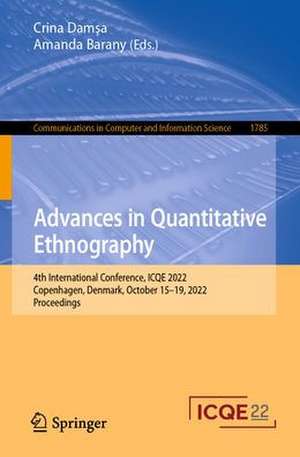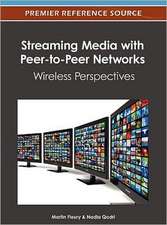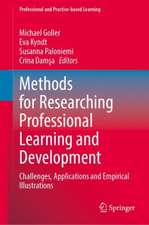Advances in Quantitative Ethnography: 4th International Conference, ICQE 2022, Copenhagen, Denmark, October 15–19, 2022, Proceedings: Communications in Computer and Information Science, cartea 1785
Editat de Crina Damşa, Amanda Baranyen Limba Engleză Paperback – 29 apr 2023
The 29 full papers included in this book were carefully reviewed and selected from 71 submissions. They were organized in topical sections as follows: QE Theory and Methodology Research; Applications in Education Contexts; and Applications in Interdisciplinary Contexts.
Din seria Communications in Computer and Information Science
- 20%
 Preț: 325.48 lei
Preț: 325.48 lei - 20%
 Preț: 669.06 lei
Preț: 669.06 lei - 20%
 Preț: 324.64 lei
Preț: 324.64 lei - 20%
 Preț: 337.85 lei
Preț: 337.85 lei - 20%
 Preț: 656.19 lei
Preț: 656.19 lei - 20%
 Preț: 659.97 lei
Preț: 659.97 lei - 20%
 Preț: 333.88 lei
Preț: 333.88 lei - 20%
 Preț: 337.52 lei
Preț: 337.52 lei - 20%
 Preț: 656.36 lei
Preț: 656.36 lei - 20%
 Preț: 656.69 lei
Preț: 656.69 lei - 20%
 Preț: 659.31 lei
Preț: 659.31 lei -
 Preț: 392.60 lei
Preț: 392.60 lei - 20%
 Preț: 329.58 lei
Preț: 329.58 lei -
 Preț: 386.00 lei
Preț: 386.00 lei - 20%
 Preț: 336.02 lei
Preț: 336.02 lei - 20%
 Preț: 334.53 lei
Preț: 334.53 lei - 20%
 Preț: 331.74 lei
Preț: 331.74 lei - 20%
 Preț: 655.85 lei
Preț: 655.85 lei - 20%
 Preț: 338.49 lei
Preț: 338.49 lei - 20%
 Preț: 333.88 lei
Preț: 333.88 lei - 20%
 Preț: 334.53 lei
Preț: 334.53 lei - 20%
 Preț: 338.68 lei
Preț: 338.68 lei - 20%
 Preț: 666.58 lei
Preț: 666.58 lei - 20%
 Preț: 307.20 lei
Preț: 307.20 lei - 20%
 Preț: 336.02 lei
Preț: 336.02 lei - 20%
 Preț: 338.68 lei
Preț: 338.68 lei - 20%
 Preț: 330.24 lei
Preț: 330.24 lei - 20%
 Preț: 660.81 lei
Preț: 660.81 lei - 15%
 Preț: 648.42 lei
Preț: 648.42 lei - 20%
 Preț: 653.56 lei
Preț: 653.56 lei - 20%
 Preț: 332.06 lei
Preț: 332.06 lei - 20%
 Preț: 337.85 lei
Preț: 337.85 lei - 20%
 Preț: 1055.29 lei
Preț: 1055.29 lei - 20%
 Preț: 836.50 lei
Preț: 836.50 lei - 20%
 Preț: 656.69 lei
Preț: 656.69 lei - 20%
 Preț: 1231.01 lei
Preț: 1231.01 lei - 20%
 Preț: 331.25 lei
Preț: 331.25 lei - 20%
 Preț: 336.02 lei
Preț: 336.02 lei - 20%
 Preț: 323.00 lei
Preț: 323.00 lei - 20%
 Preț: 113.94 lei
Preț: 113.94 lei - 20%
 Preț: 336.21 lei
Preț: 336.21 lei -
 Preț: 387.75 lei
Preț: 387.75 lei - 20%
 Preț: 470.58 lei
Preț: 470.58 lei - 20%
 Preț: 750.86 lei
Preț: 750.86 lei - 20%
 Preț: 337.00 lei
Preț: 337.00 lei - 20%
 Preț: 327.95 lei
Preț: 327.95 lei - 20%
 Preț: 410.03 lei
Preț: 410.03 lei - 20%
 Preț: 335.36 lei
Preț: 335.36 lei - 20%
 Preț: 534.59 lei
Preț: 534.59 lei - 20%
 Preț: 673.02 lei
Preț: 673.02 lei
Preț: 595.95 lei
Preț vechi: 744.93 lei
-20% Nou
Puncte Express: 894
Preț estimativ în valută:
114.05€ • 118.39$ • 95.10£
114.05€ • 118.39$ • 95.10£
Carte tipărită la comandă
Livrare economică 24 martie-07 aprilie
Preluare comenzi: 021 569.72.76
Specificații
ISBN-13: 9783031317255
ISBN-10: 3031317254
Pagini: 430
Ilustrații: XII, 430 p. 113 illus., 98 illus. in color.
Dimensiuni: 155 x 235 mm
Greutate: 0.62 kg
Ediția:1st ed. 2023
Editura: Springer Nature Switzerland
Colecția Springer
Seria Communications in Computer and Information Science
Locul publicării:Cham, Switzerland
ISBN-10: 3031317254
Pagini: 430
Ilustrații: XII, 430 p. 113 illus., 98 illus. in color.
Dimensiuni: 155 x 235 mm
Greutate: 0.62 kg
Ediția:1st ed. 2023
Editura: Springer Nature Switzerland
Colecția Springer
Seria Communications in Computer and Information Science
Locul publicării:Cham, Switzerland
Cuprins
QE Theory and Methodology Research.- The Foundations and Fundamentals of Quantitative Ethnography.- LSTM Neural Network Assisted Regex Development for Qualitative Coding.- Does Active Learning Reduce Human Coding?: A Systematic Comparison of Neural Network with nCoder.- Reducing networks of ethnographic codes co-occurrence in anthropology.- Multiclass Rotations in Epistemic Network Analysis.- Is QE Just ENA?.- The Role of Data Simulation in Quantitative Ethnography.- Ordered Network Analysis.- Creating and Discussing Discourse Networks with Research Participants: What Can we Learn?.- Modeling Collaborative Discourse with ENA using a Probabilistic Function.- Segmentation and Code Co-occurrence Accumulation: Operationalizing Relational Context with Stanza Windows.- Parsing the Continuum: Manual Segmentation of Monologic Data.- Applications in Education Contexts.- An Examination of Student Loan Borrowers’Attitudes toward Debt before and during COVID-19.- Learning through feedback: Understanding early-career teachers’ learning using online video platforms.- How Can We Co-Design Learning Analytics for Game-Based Assessment: ENA Analysis.- Automated Code Extraction from Discussion Board Text Dataset.- Mathematics Teachers’ Knowledge for Teaching Proportion: Using Two Frameworks to Understand Knowledge in Action.- Self-Regulation in Foreign Language Students’ Collaborative Discourse for Academic Writing: An Explorative Case Study on Epistemic Network Analysis.- Community At a Distance: Understanding Student Interactions in Course-Based Online Discussion Forums.- Modeling Students’ Performances in Physics Assessment Tasks Using Epistemic Network Analysis.- Computational thinking in educational policy – the relationship between goals and practices.- Understanding Detectors for SMART Model Cognitive Operation in Mathematical Problem-Solving Process: An Epistemic Network Analysis.- Applications in Interdisciplinary Contexts.- Change the Museum: Examining social media posts on museum workplace experiences to support justice, equity, diversity and inclusion (JEDI) efforts.- Ukraine War Diaries: Examining lived experiences in Kyiv during the 2022 Russian invasion.- Political Discourse Modeling with Epistemic Network Analysis and Quantitative Ethnography: Rationale and Examples.- What makes a good answer? Analyzing the Content Structure of Stack Overflow Answers.- Analyzing the Co-design Process by Engineers and Product Designers from Perspectives of Knowledge Building.- Leveraging Epistemic Network Analysis to Discern the Development of Shared Understanding between Physicians and Nurses.- Quantitative Ethnography of Policy Ecosystems: A Case Study on Climate Change Adaptation Planning.













